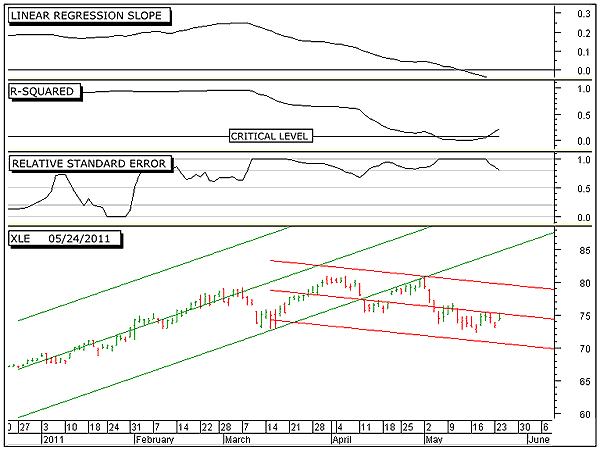
HOT TOPICS LIST
- MACD
- Fibonacci
- RSI
- Gann
- ADXR
- Stochastics
- Volume
- Triangles
- Futures
- Cycles
- Volatility
- ZIGZAG
- MESA
- Retracement
- Aroon
INDICATORS LIST
LIST OF TOPICS
PRINT THIS ARTICLE
by Alan R. Northam
Statistical analysis shows that XLE has entered into an established intermediate-term downtrend. Unless volatility subsides, however, this downtrend could be short-lived.
Position: N/A
Alan R. Northam
Alan Northam lives in the Dallas, Texas area and as an electronic engineer gave him an analytical mind from which he has developed a thorough knowledge of stock market technical analysis. His abilities to analyze the future direction of the stock market has allowed him to successfully trade of his own portfolio over the last 30 years. Mr. Northam is now retired and trading the stock market full time. You can reach him at inquiry@tradersclassroom.com or by visiting his website at http://www.tradersclassroom.com. You can also follow him on Twitter @TradersClassrm.
PRINT THIS ARTICLE
STATISTICS
XLE In Intermediate-Term Downtrend
05/25/11 08:22:00 AMby Alan R. Northam
Statistical analysis shows that XLE has entered into an established intermediate-term downtrend. Unless volatility subsides, however, this downtrend could be short-lived.
Position: N/A
| The lower panel of Figure 1 shows the daily bar chart of the Select Sector SPDR ETF (XLE) along with two 50-day linear regression trendlines and their respective upper and lower two sigma channel lines. The green linear regression trendline and its upper and lower channel lines represent the upward trend of XLE. In mid-March, price moved down to test support from the lower green channel line and then bounced back upward and continued to rally. In a healthy upward rally, price would normally rally back up to the linear regression trendline (middle green line). However, in late March to early April, price failed to reach the linear regression line before turning back down. This is known as a price failure and a warning that the upward intermediate-term rally was in trouble. |

|
| FIGURE 1: XLE, DAILY. This chart shows the daily price chart in the bottom panel along with the 50-day linear regression trendline and its upper and lower channel lines, the linear regression slope indicator in the top panel, the R-squared indicator in the second panel, and the relative standard error index in the third. |
| Graphic provided by: MetaStock. |
| |
| In early to mid-April, price broke down below the lower green channel line. This breakdown was the first signal that the intermediate-term uptrend had come to an end. Note also that after the breakdown, price rallied back up to the lower green channel line in an effort to test this line as a new line of resistance. Upon tagging the lower channel line, price then turned back down. This retest often occurs after an initial breakdown of a channel line but does not necessarily have to occur. Sometimes after a breakdown, price continues to move lower. |
| The second 50-day linear regression trendline and its upper and lower two sigma channel lines are colored red and show that the current intermediate-term trend is in the downward direction. The linear regression slope indicator in the top panel shows when the downtrend began. The downtrend began when this indicator moved below its zero line. The R-squared indicator in the next panel also shows when the downtrend became statistically significant. This occurred when the R-squared indicator moved above its critical level. "Statistically significant" means that there is a high probability that the intermediate-term downtrend will continue. However, I have found that when a new significant trend is established, as is the case here, verification is in order. This verification occurs when the relative standard error index (RSEI) moves below 0.2. Until this occurs, I have found that a newly established significant trend is usually corrective and not the beginning of a more prolonged and steeper downward rally. Currently, RSEI remains above 0.8, indicating that volatility remains high. High volatility is the norm during market corrections. |
| In conclusion, the upward intermediate-term trend of XLE has come to an end and a new intermediate term downtrend has been established. However, this newly established downtrend has not yet been confirmed. Confirmation will come when RSEI moves below 0.2. Unless RSEI moves below 0.2, the intermediate-term downtrend could be short-lived and a new intermediate-term uptrend could be in XLE's future. |
Alan Northam lives in the Dallas, Texas area and as an electronic engineer gave him an analytical mind from which he has developed a thorough knowledge of stock market technical analysis. His abilities to analyze the future direction of the stock market has allowed him to successfully trade of his own portfolio over the last 30 years. Mr. Northam is now retired and trading the stock market full time. You can reach him at inquiry@tradersclassroom.com or by visiting his website at http://www.tradersclassroom.com. You can also follow him on Twitter @TradersClassrm.
| Garland, Tx | |
| Website: | www.tradersclassroom.com |
| E-mail address: | inquiry@tradersclassroom.com |
Click here for more information about our publications!
PRINT THIS ARTICLE

|

Request Information From Our Sponsors
- StockCharts.com, Inc.
- Candle Patterns
- Candlestick Charting Explained
- Intermarket Technical Analysis
- John Murphy on Chart Analysis
- John Murphy's Chart Pattern Recognition
- John Murphy's Market Message
- MurphyExplainsMarketAnalysis-Intermarket Analysis
- MurphyExplainsMarketAnalysis-Visual Analysis
- StockCharts.com
- Technical Analysis of the Financial Markets
- The Visual Investor
- VectorVest, Inc.
- Executive Premier Workshop
- One-Day Options Course
- OptionsPro
- Retirement Income Workshop
- Sure-Fire Trading Systems (VectorVest, Inc.)
- Trading as a Business Workshop
- VectorVest 7 EOD
- VectorVest 7 RealTime/IntraDay
- VectorVest AutoTester
- VectorVest Educational Services
- VectorVest OnLine
- VectorVest Options Analyzer
- VectorVest ProGraphics v6.0
- VectorVest ProTrader 7
- VectorVest RealTime Derby Tool
- VectorVest Simulator
- VectorVest Variator
- VectorVest Watchdog
